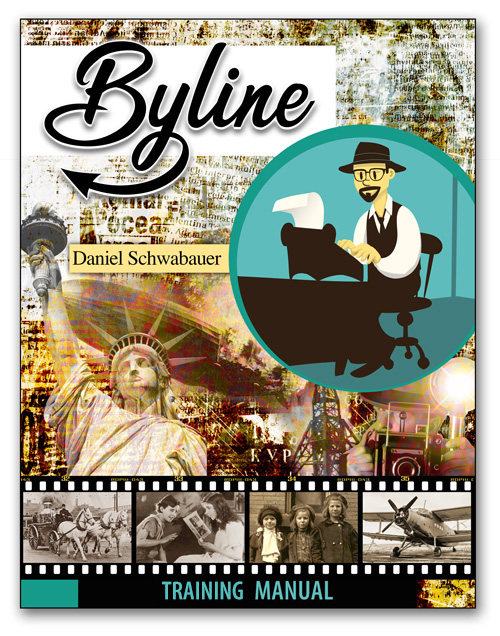The Byline “chronojournalism” course comes from Daniel Schwabauer, creator of the outstanding One Year Adventure Novel and Cover Story courses. While it should be ideal for high schools students, it might also be used with some students at junior high level.
“Chronojournalism” reflects the course’s integration of history with essay writing skills. Students will write as journalists for the Metropolitan World newspaper, dealing with true historical stories and people. As Schwabauer puts it, “[T]hey’ve been hired as chronojournalists, reporters who dig up forgotten stories from the past and make them relevant to modern audiences” (Byline Teacher’s Guide, p. 1).
Students will essentially be writing essays. They will write newspaper articles that answer a reporter’s basic questions: who, what, when, where, why, and how. These are the themes for each of the course's six units. Along the way, they will be learning to write descriptive, narrative, expository, and persuasive essays. Their essays will be written in the form of “current event” reports, opinion columns, reviews, personality features, investigative reports, editorials, sports features, editorials, columns, and press releases. These include writing muckraking and propaganda pieces, assignments that students often love to sink their teeth into. Lessons also include writing two poems, both about famous people.
Lessons walk students through the writing process, focusing on different parts of an article (i.e., the lead, the body, the conclusion) or on stylistic or construction elements for particular types of articles.
This year-long course can be used by students working independently, although a parent or teacher will need to make sure students are completing assignments, evaluate their work, and maybe discuss the assignment and writing ideas.
The course may also be used for group classes. Group discussion and sharing are likely to provide positive motivation. The Teacher’s Guide has specific suggestions as to how to use it with groups.
Components for the course include:
- Set of six DVDs with the video lectures plus an explanation of how to use the course. Streamed videos are available as an alternative to the DVDs.
- Byline Teacher’s Guide with course instructions and brief notes for each week listing such things as the project to be completed, learning goals, grading suggestions, expectations for the Reporter’s Notebook work, and when to administer tests. The Teacher’s Guide also includes all of the readings that are incorporated into the Byline Training Manual but not the rest of the lesson material in the student book. Six unit tests and answer keys are at the back of the guide along with reproducible pages for evaluating student work and course grading. The multiple-choice tests are given at the end of each of the course’s six units. Online versions of the tests are available on the Byline website.
- Byline Training Manual which is the student worktext. Students will write directly in this book. Lessons often include actual articles by literary luminaries such as Ernest Hemingway, H.L. Mencken, Jack London, and G.K. Chesterton that illustrate the concept or technique being taught. While students might do some literary analysis as they reflect on these articles, the lessons focus primarily on writing projects, walking students through the various steps to create each article. A number of lessons will be dedicated to each article, working on different aspects of the article to help students complete manageable chunks before combining them into a completed article. Students work through the lesson instructions, reading material, and assignments in the Training Manual. They are often told what and when to write in their Reporter’s Notebook.
- The Metro World Reporter’s Notebook looks like it consists mostly of lined pages, but there’s more to it. Students are taught to differentiate between facts and emotions. Pages are designed for students to write particular information for each lesson, often noting facts on the top half of a page and emotional reactions on the bottom. Students should also use the notebook to record things that strike them as “interesting or odd or profound.”
- Two newspapers include stories that correspond with various lessons. These are optional, but they serve well as examples and inspiration.
You will need to purchase a Byline set—either the set of DVDs or the streamed option for the lectures. Each set includes one student kit with the Training Manual, Reporter’s Notebook, and two sample newspapers. Additional students will each need a student kit with these items.
Videos are primarily lectures by Schwabauer, but they also incorporate clips from old videos and newly created segments that appear old. The new segments feature the character Madge Witherspoon, owner of Metropolitan World. Videos are engaging and short enough to keep the student’s attention.
The Byline Training Manual ties together the various course elements. Typically, a student watches the video lesson, reads and completes the lesson in the Byline Training Manual, takes notes in their Reporter’s Notebook, and works on the writing assignment as explained in the manual. Students will write 16 to 22 articles in addition to exercises and journal entries. Younger students or those who find the course too challenging as is can follow the Flex Track as explained in the Byline Teacher’s Guide on page 4. They will complete all lessons, working on outlines and article components, but they will write only 16 complete articles.
Students will need to complete some research for most of their articles. Schwabauer has created a resource page with links to encyclopedias and collections such as Historic Newspapers, the Historical Text Archive, and the Government Document Center that students should use for research. These limited options for research keep things more manageable for students. The resource page also has links to a citations guide and Purdue Online Writing Lab’s usage and grammar help. A few other links take students to particular sites for videos or information students need for specific assignments. You will need to locate and possibly bookmark this page.
As with Schwabauer’s other courses, Byline is very creative. It draws students back into the historical past with intriguing stories and fascinating biographies of personalities. It then uses those effectively as springboards to essay writing. I expect that most students will very much enjoy this approach for learning to write essays.











